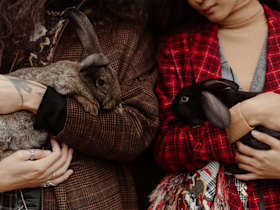The Truth About Bunnies: They’re More Work Than You Realize
So you want a bunny? Here’s the reality check you need before committing to a pet rabbit.
So you want a bunny? Here’s the reality check you need before committing to a pet rabbit.
by Cammi Morgan, | March 21, 2025

Andrey Pavlov / Stocksy
Thinking about welcoming a bunny into your life? While they make delightful companions, their care needs can be more involved than you might think. With proper care and preparation, you can create a happy and healthy home for your new rabbit friend. Unfortunately, the misconception that bunnies are easy pets has contributed to rabbits being the third most relinquished pet to shelters, after dogs and cats. Below, we’ll delve into what companion rabbits need to thrive.
Yes, rabbits make wonderful pets and family companions. They are gentle, affectionate, and intelligent. A solid understanding of bunny care 101 and how to keep bunnies healthy and happy is crucial to being a good pet parent.
A person best suited to raise a bunny will:
Have the time and resources to devote to their care
Regularly be at home
Have adequate indoor and outdoor space
Provide varied and consistent enrichment
Be committed to daily bonding and social engagement with their rabbits
While bunnies may seem like low-maintenance pets, they have social, enrichment, companionship, and exercise needs similar to that of a family dog or cat. So, it’s not advisable to adopt a rabbit on a whim, gift them to someone unprepared, or bring one home if you aren’t ready to take on their various care needs. But with the right preparation, research, and commitment to care, you can provide a wonderful home for pet rabbits.

From diet to exercise needs, here’s what you need to know about caring for a rabbit.
Caring for a bunny isn’t hard — but bunnies do require more hands-on pet parenting than you might think. The ease of rabbit care really depends on how prepared you are and your lifestyle. Proper planning and setup are critical to providing rabbits with a safe, supportive, species-appropriate, and enriching environment. Here are seven often-overlooked facts to help new pet parents navigate the bunny learning curve.

Liana Tril / Pexels
Rabbits are social animals who live in large colonies made of complex social groups. Being able to participate in social behaviors — such as grooming each other, group sleeping and foraging, and collective play and exploration — is crucial to their well-being.
Adopting only one bunny makes sense for those who work or study from home and can provide consistent social engagement with their rabbit throughout the day. Ultimately, though, housing two or more well-socialized rabbits together is typically a much better setup for their mental, physical, and emotional well-being.
According to the Rabbit Welfare Association & Fund (RWAF), the best pairing for pet rabbits is typically two opposite-sex bunnies who are spayed or neutered. Making sure your pet bunnies can’t reproduce is vital to not adding more rabbits in need of homes to shelters.
Sadly, it is reported that 72 percent of relinquished rabbits weren’t neutered, and the most common reason (30 percent) for giving them up was “too many rabbits/unplanned litters.” The good news is that you can often adopt an already-bonded pair of neutered rabbits from a rescue or shelter.
Simply providing a cage or hutch with bedding, food pellets, and water does not meet the dietary, social, shelter, and enrichment needs of our hoppy friends. Instead, the following supplies are required:
A comfortable hutch with ample space and a separate, bunny-proofed area for enrichment and exercise
Plenty of toys for chewing and pushing around (DIY cardboard toys and solid plastic toys for human babies can work great)
A litter box with rabbit-safe litter
Soft, comfortable, and warm rabbit-safe bedding such as high-quality straw and fleece blankets
Food that provides a balanced diet
Fresh and clean water
Tunnels and hideaways
Grooming supplies
Rabbit-appropriate first aid kit
Carrier for transporting
Tasty treats and snacks for foraging
Platforms
Areas with fresh dirt or sand for digging
Dust area for dust baths and rolling
A safe, enclosed space for outdoor enrichment, play, and exercise
Air conditioning or fans to keep them cool in temps above 77 degrees

weyo / AdobeStock
In the wild, rabbits live in warrens consisting of burrows that can each reach about nine feet deep and up to about 135 feet long. They are not sedentary animals and need ample space for exploration, exercise, and play.
According to the People’s Dispensary for Sick Animals (PDSA), rabbits need a spacious hutch that mimics their natural environment and allows them to sprint and hop around, jump to their fullest capability, fully stretch out, and stand up on their back legs without the top of the enclosure touching their ears. The bare minimum size for two rabbits is 10 feet by 6 feet by 3 feet. You should put platforms, tunnels, bedding, fresh water, and toys inside.
Rabbits also need a spacious and secure area for exercise. Ideally, this space should be accessible at all times. If needed, you can connect a rabbit-safe tubed tunnel from the hutch to the exercise area so your bunnies can come and go from one space to the other as they please.
As small and fragile prey animals, a rabbit can feel unsafe being picked up or handled by people. They can also take a while to warm up to their new adopters and may be skittish or wary when approached or handled. It’s important to move at their comfort level and try to imagine how they might feel as a little fluff ball who is on the menu of many predators.
Picking up or petting a rabbit who isn’t ready for that interaction can damage trust, and they may associate you with scary experiences. As much as you want to snuggle with your new buddy, allow the bunny to approach you on their terms by quietly sharing space with them, and associate handling with positive experiences by feeding them small bits of tasty snacks. The safer and less pressured your rabbit feels, the more likely they are to trust and bond with you.
New bunny pet parents often underestimate how varied a rabbit’s diet needs to be. While cartoons might have you thinking they live on carrots, that’s far from enough to keep them healthy. Bunnies actually need a diverse diet with plenty of hay fiber.
The Royal Society for the Prevention of Cruelty to Animals (RSPCA) says pet rabbits need a balanced diet consisting of a ratio of 80 percent fresh, high-quality grass hay (such as timothy hay), 15 percent fresh leafy greens and vegetables, and no more than five percent of high-quality rabbit pellets. Three to five types of rabbit-safe greens and vegetables should be rotated into their diet weekly and fed throughout the day for foraging enrichment.

KCULP / AdobeStock
While adopting a rabbit from a shelter or rescue is often inexpensive, they still have other initial setup costs and ongoing care expenses. The PDSA estimates that a pair of indoor pet bunnies will cost you roughly $7,300 to $10,000 over their lifetimes. The lifespan of a pet rabbit typically lasts eight to 12 years. Care costs include the setup of their initial shelter and exercise area, plus ongoing expenses such as food, bedding, toys, litter, healthcare, pet insurance, grooming tools, and cleaning supplies.
Bunnies are a popular gift during springtime for children. But contrary to popular belief, rabbits are not pets suitable for children as their primary caretakers. In fact, one study found that “child no longer interested” accounted for 13.1 percent of the reasons given for surrender. This underscores the need for adults to commit to the care of an adopted rabbit even if a child loses interest.
Beyond caring for the rabbit, children tend to be loud, fast, and a bit unpredictable — all things that can be frightening for a small rabbit. If you’re considering a rabbit, it’s essential to teach your children how to handle, care for, and connect with them in a way that feels safe and comfortable for the bunny.
If you’re considering adopting a rabbit, one way to make sure you have a lifestyle and environment that can accommodate a pet bunny or rabbit is by reaching out to adoption counselors at your local rescue or shelter for advice.
You can also foster a rabbit or bonded pair to learn more about rabbit behavior and daily care, and to help you determine if you’re ready to commit to an adoption. If you decide adoption isn’t the move for you, fostering will still help the rabbits and allow space for the rescue to take on additional pets in need.
If you are ready for adoption, start by browsing rabbits available for adoption in your area through Adopt a Pet. Some rescues will allow you to foster, then adopt, your buddy (or buddies) if you’re a great pet-parent match. Or you can visit a shelter in person for more bunny meet-and-greets.
Rabbits live eight to twelve years on average, making them a long-term companion. Just like adopting any pet, these pets require a big commitment, so be sure you’re ready to provide a loving home for your bunny for well over a decade.
Yes, you can foster a rabbit. Fostering bunnies is a great way to test the waters of adoption and help a bunny in need at the same time.

Cammi Morgan is a nature and pet care writer living off-grid with her pack of rescue and foster dogs in the mountains of Southeast Appalachia. In addition to her work with Adopt a Pet, she has contributed to Animal Wellness Magazine, PetsRadar, Global Comment, A-Z Animals and other online publications. Her passions include animal rescue, mycology, hiking, and caving.

Foster & Volunteer

Adoption Advice

Adoption Advice

Adoption Advice
The lifespan of a pet rabbit will affect both your lifestyle and your emotions. Find out what to expect when you adopt a rabbit.

Adoption Advice
These giant guinea pigs are smart and social, so what could go wrong? Read on to better understand why these animals don’t make good pets, and why they’re outlawed in several places.

Adoption Advice
Wondering about tax savings for pet expenses? Learn about pet tax deductions to understand how to claim your pet on taxes.

Adoption Advice
Is the responsibility of taking care of your pet causing you to worry about your budget? Rest assured, there are a number of ways to minimize this financial stress.

Adoption Advice
Dealing with high vet bills? See assistance options for affordable pet care. Get the support your pet needs without breaking the bank.

Shelters & Rescue
In truth, most animal shelters will identify and treat a pet’s health problems pretty quickly. They’ll have all the information you need.